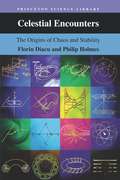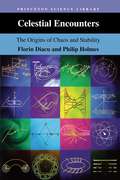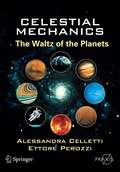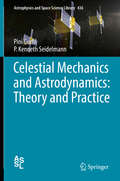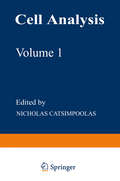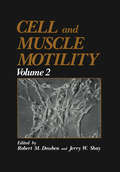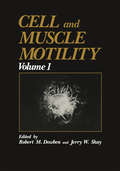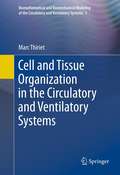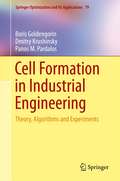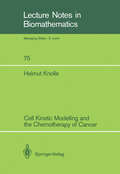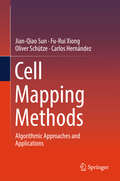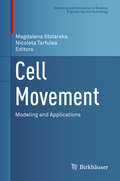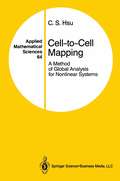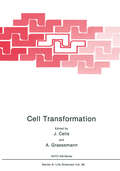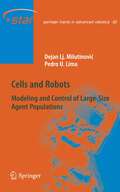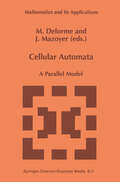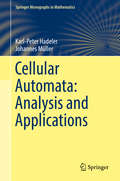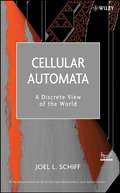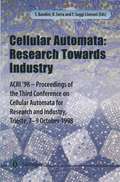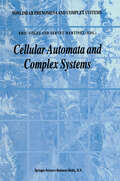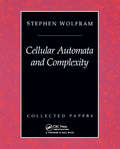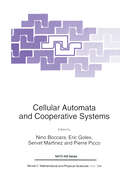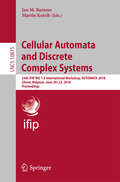- Table View
- List View
Celestial Encounters: The Origins of Chaos and Stability (PDF)
by Florin Diacu Philip HolmesCelestial Encounters is for anyone who has ever wondered about the foundations of chaos. In 1888, the 34-year-old Henri Poincaré submitted a paper that was to change the course of science, but not before it underwent significant changes itself. "The Three-Body Problem and the Equations of Dynamics" won a prize sponsored by King Oscar II of Sweden and Norway and the journal Acta Mathematica, but after accepting the prize, Poincaré found a serious mistake in his work. While correcting it, he discovered the phenomenon of chaos. Starting with the story of Poincaré's work, Florin Diacu and Philip Holmes trace the history of attempts to solve the problems of celestial mechanics first posed in Isaac Newton's Principia in 1686. In describing how mathematical rigor was brought to bear on one of our oldest fascinations--the motions of the heavens--they introduce the people whose ideas led to the flourishing field now called nonlinear dynamics. In presenting the modern theory of dynamical systems, the models underlying much of modern science are described pictorially, using the geometrical language invented by Poincaré. More generally, the authors reflect on mathematical creativity and the roles that chance encounters, politics, and circumstance play in it.
Celestial Encounters: The Origins of Chaos and Stability (Princeton Science Library)
by Florin Diacu Philip HolmesCelestial Encounters is for anyone who has ever wondered about the foundations of chaos. In 1888, the 34-year-old Henri Poincaré submitted a paper that was to change the course of science, but not before it underwent significant changes itself. "The Three-Body Problem and the Equations of Dynamics" won a prize sponsored by King Oscar II of Sweden and Norway and the journal Acta Mathematica, but after accepting the prize, Poincaré found a serious mistake in his work. While correcting it, he discovered the phenomenon of chaos. Starting with the story of Poincaré's work, Florin Diacu and Philip Holmes trace the history of attempts to solve the problems of celestial mechanics first posed in Isaac Newton's Principia in 1686. In describing how mathematical rigor was brought to bear on one of our oldest fascinations--the motions of the heavens--they introduce the people whose ideas led to the flourishing field now called nonlinear dynamics. In presenting the modern theory of dynamical systems, the models underlying much of modern science are described pictorially, using the geometrical language invented by Poincaré. More generally, the authors reflect on mathematical creativity and the roles that chance encounters, politics, and circumstance play in it.
Celestial Mechanics: The Waltz of the Planets (Springer Praxis Books)
by Alessandra Celletti Ettore PerozziThe aim of this book is to demonstrate to a wider audience, as well as to a more skilled audience, the many fascinating aspects of modern celestial mechanics. It sets out to do this without the use of mathematics. After giving the reader the technical tools needed for a basic understanding of the underlying physical phenomena (using only elementary mathematics), facts and figures are provided on historical events, modern discoveries and future applications. Contents are divided into major topics where the three "souls" of modern celestial mechanics (dynamical systems, Solar System and stellar systems, spaceflight dynamics) play a major role.
Celestial Mechanics and Astrodynamics: Theory and Practice (Astrophysics and Space Science Library #436)
by Pini Gurfil P. Kenneth SeidelmannThis volume is designed as an introductory text and reference book for graduate students, researchers and practitioners in the fields of astronomy, astrodynamics, satellite systems, space sciences and astrophysics. The purpose of the book is to emphasize the similarities between celestial mechanics and astrodynamics, and to present recent advances in these two fields so that the reader can understand the inter-relations and mutual influences. The juxtaposition of celestial mechanics and astrodynamics is a unique approach that is expected to be a refreshing attempt to discuss both the mechanics of space flight and the dynamics of celestial objects. “Celestial Mechanics and Astrodynamics: Theory and Practice” also presents the main challenges and future prospects for the two fields in an elaborate, comprehensive and rigorous manner. The book presents homogenous and fluent discussions of the key problems, rendering a portrayal of recent advances in the field together with some basic concepts and essential infrastructure in orbital mechanics. The text contains introductory material followed by a gradual development of ideas interweaved to yield a coherent presentation of advanced topics.
Cell Analysis: Volume 1
by Nicholas CatsimpoolasThe selective combination of physical, biochemical, and immunological prin ciples, along with new knowledge concerning the biology of cells and advance ments in engineering and computer sciences, has made possible the emergence of highly sophisticated and powerful methods for the analysis of cells and their constituents. This series on Cell Analysis is, therefore, aiming at providing the theoretical and practical background on how these methods work and what kind of information can be obtained. Cell Analysis will cover techniques on cell separation, cell identification and classification, characterization of orga nized cellular components, functional properties of cells, and cell interactions. Applications in cell biology, immunology, genetics, toxicology, specific diseases, diagnostics and therapeutics, and other areas will be covered whenever relevant results exist. Nicholas Catsimpoolas Boston, Massachusetts vii Contents Chapter I Quantification of Red Blood Cell Morphology James W. Bacus I. History .. II. Details of Red Cell Measurements. 3 III. Cell Sample Population Distributions. 11 IV. Discussion and Summary. 25 References. 30 Chapter 2 Laser Microirradiation and Computer Video Optical Microscopy in Cell Analysis Michael W. Berns and Robert J. Walter I. Introduction 33 II. Laser Microbeams 34 III. Computer-Enhanced Video Microscopy for Laser Microsurgery.
Cell and Muscle Motility: Volume 2
by Robert M. Dowben Jerry W. ShayThe contributions to this volume were presented at a Symposium entitled "Current Topics in Muscle and Nonmuscle Motility" held in Dallas 19-21 November 1980 under the auspices of the A. Webb Roberts Center for Con tinuing Education, Baylor University Medical Center Dallas, and the Univer sity of Texas Health Science Center at Dallas. This very useful opportunity for a group of active investigators in motility to meet and discuss their latest findings was made possible in part by the income from an endowment fund established by a generous gift from Dr. Albert P. D'Errico in the Baylor University Medical Center. Dr. D'Errico was the first formally-trained neurosurgeon to practice in the Dallas area, the first Chief of Neurological Surgery, and a member of the Medical Board of the Baylor University Medi cal Center Dallas (1947 -1964). The income from this fund is used to promote the dissemination of up-to-date information in the Neurosciences, to provide intellectual stimulation, to add to the fund of knowledge, and improve the skills of neurosurgeons, neurologists, internists, and others in specialized fields of medicine. We are all indebted for this generous gift that made this enriching educational experience possible. We are also grateful for support the Symposium received from Electron Microscopy Sciences, Forma Scien tific, J. E. O. L. USA, Inc. , Ladd Research Industries, M. J. O. Diatome Co. , Or ganon Co. , Upjohn Co. , G. D. Searle & Co. , and Smith, Kline and French. Robert M.
Cell and Muscle Motility
by Robert M. Dowben Jerry W. ShayMotility is a fundamental property of living systems, from the cytoplasmic streaming of unicellular organisms to the most highly differentiated and devel oped contractile system of higher organisms, striated muscle. Research on var ious aspects of motile systems in muscle and undifferentiated or non muscle cells has been developing at an ever more rapid pace in the laboratories of investiga tors with a wide variety of backgrounds using methodologies varying from me chanics to the most sophisticated physical measurements. Significant contri butions to our understanding of motility are coming from the disciplines of cell biology, biochemistry, pharmacology, molecular biology, biophysics, and physiology. The findings have relevance not only to basic scientists but to clinicians in such diverse fields as cardiology and neurology and to scientists in the more traditional physical sciences. Cell and Muscle Motility is a new multivolume series of essays by distinguished research workers in various fields whose work has a common thread of dealing with one aspect or another of motility. The essays are meant to focus on topics of current interest, to be critical rather than exhaustive, and to indicate the current trends of research efforts. The series is intended to foster an interchange of concepts among various workers in the field and to serve as a reference for students and workers who wish to familiarize themselves with the most current progress in motility.
Cell and Tissue Organization in the Circulatory and Ventilatory Systems (Biomathematical and Biomechanical Modeling of the Circulatory and Ventilatory Systems #1)
by Marc ThirietThe volumes in this authoritative series present a multidisciplinary approach to modeling and simulation of flows in the cardiovascular and ventilatory systems, especially multiscale modeling and coupled simulations. The cardiovascular and respiratory systems are tightly coupled, as their primary function is to supply oxygen to and remove carbon dioxide from the body's cells. Because physiological conduits have deformable and reactive walls, macroscopic flow behavior and prediction must be coupled to nano- and microscopic events in a corrector scheme of regulated mechanisms. Therefore, investigation of flows of blood and air in physiological conduits requires an understanding of the biology, chemistry, and physics of these systems together with the mathematical tools to describe their functioning. The present volume is devoted to cellular events that allow adaptation to environmental conditions, particularly mechanotransduction. It begins with cell organization and a survey of cell types in the vasculature and respiratory tract. It then addresses cell structure and functions, especially in interactions with adjoining cells and matrix.
Cell Formation in Industrial Engineering: Theory, Algorithms and Experiments (Springer Optimization and Its Applications #79)
by Boris Goldengorin Dmitry Krushinsky Panos M. PardalosThis book focuses on a development of optimal, flexible, and efficient models and algorithms for cell formation in group technology. Its main aim is to provide a reliable tool that can be used by managers and engineers to design manufacturing cells based on their own preferences and constraints imposed by a particular manufacturing system. This tool could potentially lower production costs by minimizing other costs in a number of areas, thereby increasing profit in a manufacturing system. In the volume, the cell formation problem is considered in a systematic and formalized way, and several models are proposed, both heuristic and exact. The models are based on general clustering problems, and are flexible enough to allow for various objectives and constraints. The authors also provide results of numerical experiments involving both artificial data from academic papers in the field and real manufacturing data to certify the appropriateness of the models proposed. The book was intended to suit the broadest possible audience, and thus all algorithmic details are given in a detailed description with multiple numerical examples and informal explanations are provided for the theoretical results. In addition to managers and industrial engineers, this book is intended for academic researchers and students. It will also be attractive to many theoreticians, since it addresses many open problems in computer science and bioinformatics.
Cell Kinetic Modelling and the Chemotherapy of Cancer (Lecture Notes in Biomathematics #75)
by Helmut KnolleDuring the last 30 years, many chemical compounds that are active against tumors have been discovered or developed. At the same time, new methods of testing drugs for cancer therapy have evolved. nefore 1964, drug testing on animal tumors was directed to observation of the incfease in life span of the host after a single dose. A new approach, in which the effects of multiple doses on the proliferation kinetics of the tumor in vivo as well as of cell lines in vitro are investigated, has been outlined by Skipper and his co-workers in a series of papers beginning in 1964 (Skipper, Schabel and Wilcox, 1964 and 1965). They also investigated the influence of the time schedule in the treatment of experimental tumors. Since the publication of those studies, cell population kinetics cannot be left out of any discussion of the rational basis of chemotherapy. When clinical oncologists began to apply cell kinetic concepts in practice about 15 years ago, the theoretical basis was still very poor, in spite of Skipper's progress, and the lack of re levant cytokinetic and pharmacologic data was apparent. Subsequently, much theoretical work has been done and many cell kinetic models have been elaborated (for a review see Eisen, 1977).
Cell Mapping Methods: Algorithmic Approaches and Applications (Nonlinear Systems And Complexity Ser. #99)
by Jian-Qiao Sun Fu-Rui Xiong Oliver Schütze Carlos HernándezThis book presents the latest algorithmic developments in the cell-mapping method for the global analysis of nonlinear dynamic systems, global solutions for multi-objective optimization problems, and global solutions for zeros of complex algebraic equations. It also discusses related engineering and scientific applications, including the nonlinear design of structures for better vibration resistance and reliability; multi-objective, structural-acoustic design for sound abatement; optimal multi-objective design of airfoils for better lift; and optimal multi-objective design of linear and nonlinear controls with or without time delay.The first book on the subject to include extensive Matlab and C++ codes, it presents various implementation algorithms of the cell-mapping method, enabling readers to understand how the method works and its programming aspects. A link to the codes on the Springer website will be provided to the readers.
The Cell Method for Electrical Engineering and Multiphysics Problems: An Introduction (Lecture Notes in Electrical Engineering #230)
by Piergiorgio Alotto Fabio Freschi Maurizio Repetto Carlo RossoThis book presents a numerical scheme for the solution of field problems governed by partial differential equations: the cell method. The technique lends itself naturally to the solution of multiphysics problems with several interacting phenomena. The Cell Method, based on a space-time tessellation, is intimately related to the work of Tonti and to his ideas of classification diagrams or, as they are nowadays called, Tonti diagrams: a graphical representation of the problem's equations made possible by a suitable selection of a space-time framework relating physical variables to each other. The main features of the cell method are presented and links with many other discrete numerical methods (finite integration techniques, finite difference time domain, finite volumes, mimetic finite differences, etc.) are discussed. After outlining the theoretical basis of the method, a set of physical problems which have been solved with the cell method is described. These single and multiphysics problems stem from the authors' research experience in the fields of electromagnetism, elasticity, thermo-elasticity and others. Finally, the implementation of the numerical technique is described in all its main components: space-time discretization, problem formulation, solution and representation of the resulting physical fields.
Cell Movement: Modeling And Applications (Modeling and Simulation in Science, Engineering and Technology)
by Magdalena Stolarska Nicoleta TarfuleaThis book contains a collection of original research articles and review articles that describe novel mathematical modeling techniques and the application of those techniques to models of cell motility in a variety of contexts. The aim is to highlight some of the recent mathematical work geared at understanding the coordination of intracellular processes involved in the movement of cells. This collection will benefit researchers interested in cell motility as well graduate students taking a topics course in this area.
Cell-to-Cell Mapping: A Method of Global Analysis for Nonlinear Systems (Applied Mathematical Sciences #64)
by C.S. HsuFor many years, I have been interested in global analysis of nonlinear systems. The original interest stemmed from the study of snap-through stability and jump phenomena in structures. For systems of this kind, where there exist multiple stable equilibrium states or periodic motions, it is important to examine the domains of attraction of these responses in the state space. It was through work in this direction that the cell-to-cell mapping methods were introduced. These methods have received considerable development in the last few years, and have also been applied to some concrete problems. The results look very encouraging and promising. However, up to now, the effort of developing these methods has been by a very small number of people. There was, therefore, a suggestion that the published material, scattered now in various journal articles, could perhaps be pulled together into book form, thus making it more readily available to the general audience in the field of nonlinear oscillations and nonlinear dynamical systems. Conceivably, this might facilitate getting more people interested in working on this topic. On the other hand, there is always a question as to whether a topic (a) holds enough promise for the future, and (b) has gained enough maturity to be put into book form. With regard to (a), only the future will tell. With regard to (b), I believe that, from the point of view of both foundation and methodology, the methods are far from mature.
Cells and Robots: Modeling and Control of Large-Size Agent Populations (Springer Tracts in Advanced Robotics #32)
by Dejan Lj. Milutinovic Pedro U. LimaThis monograph has arisen from the multidisciplinary research extending over biology, robotics and hybrid systems theory. It is inspired by modeling reactive behavior of the immune system cell population, where each cell is considered an independent agent. The authors formulate the optimal control of maximizing the probability of robotic presence in a given region and discuss the application of the Minimum Principle for partial differential equations to this problem.
Cellular Automata: A Parallel Model (Mathematics and Its Applications #460)
by M. Delorme J MazoyerCellular automata can be viewed both as computational models and modelling systems of real processes. This volume emphasises the first aspect. In articles written by leading researchers, sophisticated massive parallel algorithms (firing squad, life, Fischer's primes recognition) are treated. Their computational power and the specific complexity classes they determine are surveyed, while some recent results in relation to chaos from a new dynamic systems point of view are also presented. Audience: This book will be of interest to specialists of theoretical computer science and the parallelism challenge.
Cellular Automata: Analysis and Applications (Springer Monographs in Mathematics)
by Karl-Peter Hadeler Johannes MüllerThis book provides an overview of the main approaches used to analyze the dynamics of cellular automata. Cellular automata are an indispensable tool in mathematical modeling. In contrast to classical modeling approaches like partial differential equations, cellular automata are relatively easy to simulate but difficult to analyze. In this book we present a review of approaches and theories that allow the reader to understand the behavior of cellular automata beyond simulations. The first part consists of an introduction to cellular automata on Cayley graphs, and their characterization via the fundamental Cutis-Hedlund-Lyndon theorems in the context of various topological concepts (Cantor, Besicovitch and Weyl topology). The second part focuses on classification results: What classification follows from topological concepts (Hurley classification), Lyapunov stability (Gilman classification), and the theory of formal languages and grammars (Kůrka classification)? These classifications suggest that cellular automata be clustered, similar to the classification of partial differential equations into hyperbolic, parabolic and elliptic equations. This part of the book culminates in the question of whether the properties of cellular automata are decidable. Surjectivity and injectivity are examined, and the seminal Garden of Eden theorems are discussed. In turn, the third part focuses on the analysis of cellular automata that inherit distinct properties, often based on mathematical modeling of biological, physical or chemical systems. Linearity is a concept that allows us to define self-similar limit sets. Models for particle motion show how to bridge the gap between cellular automata and partial differential equations (HPP model and ultradiscrete limit). Pattern formation is related to linear cellular automata, to the Bar-Yam model for the Turing pattern, and Greenberg-Hastings automata for excitable media. In addition, models for sand piles, the dynamics of infectious d
Cellular Automata: A Discrete View of the World (Wiley Series in Discrete Mathematics & Optimization #45)
by Joel L. SchiffAn accessible and multidisciplinaryintroduction to cellular automata As the applicability of cellular automata broadens and technology advances, there is a need for a concise, yet thorough, resource that lays the foundation of key cellularautomata rules and applications. In recent years, Stephen Wolfram's A New Kind of Science has brought the modeling power that lies in cellular automata to the attentionof the scientific world, and now, Cellular Automata: A Discrete View of the World presents all the depth, analysis, and applicability of the classic Wolfram text in a straightforward, introductory manner. This book offers an introduction to cellular automata as a constructive method for modeling complex systems where patterns of self-organization arising from simple rules are revealed in phenomena that exist across a wide array of subject areas, including mathematics, physics, economics, and the social sciences. The book begins with a preliminary introduction to cellular automata, including a brief history of the topic along with coverage of sub-topics such as randomness, dimension, information, entropy, and fractals. The author then provides a complete discussion of dynamical systems and chaos due to their close connection with cellular automata and includes chapters that focus exclusively on one- and two-dimensional cellular automata. The next and most fascinating area of discussion is the application of these types of cellular automata in order to understand the complex behavior that occurs in natural phenomena. Finally, the continually evolving topic of complexity is discussed with a focus on how to properly define, identify, and marvel at its manifestations in various environments. The author's focus on the most important principles of cellular automata, combined with his ability to present complex material in an easy-to-follow style, makes this book a very approachable and inclusive source for understanding the concepts and applications of cellular automata. The highly visual nature of the subject is accented with over 200 illustrations, including an eight-page color insert, which provide vivid representations of the cellular automata under discussion. Readers also have the opportunity to follow and understand the models depicted throughout the text and create their own cellular automata using Java applets and simple computer code, which are available via the book's FTP site. This book serves as a valuable resource for undergraduate and graduate students in the physical, biological, and social sciences and may also be of interest to any reader with a scientific or basic mathematical background.
Cellular Automata: ACRI’98 — Proceedings of the Third Conference on Cellular Automata for Research and Industry, Trieste, 7–9 October 1998
by Roberto Serra Furio Suggi LiveraniCellular Automata (CA), about to enter their fifties, are coming of age, seen by the breadth and quality of CA-related research carried out worldwide, as well as by the appearance of interesting applications to real world problems. The papers collected in this book, presented at ACRI 98 (Third Conference on Cellular Automata for Research and Industry -7-9 October 1998), further demonstrate the vitality of this line ofresearch. Until some years ago, a researcher interested in dynamical modelling of spatially of the partial extended systems had only one language at his disposal, namely that differential equations (PDE). These are wonderful tools to use when an analytical solution can be found or a perturbative approach can provide a good approximation of the observed phenomena. The use of digital computers has enormously expanded the explanatory and predictive power of partial differential equations by allowing one to treat cases which had been outside the scope of a "pen and pencil" approach. However, it has also opened up a way to new formalisms which are able to describe interesting phenomena and are, at the same time, well-suited for digital simulation.
Cellular Automata and Complex Systems (Nonlinear Phenomena and Complex Systems #3)
by E. Goles Servet MartínezThis book contains the courses given at the Fifth School on Complex Systems held at Santiago, Chile, from 9th .to 13th December 1996. At this school met researchers working on areas related with recent trends in Complex Systems, which include dynamical systems, cellular automata, symbolic dynamics, spatial systems, statistical physics and thermodynamics. Scientists working in these subjects come from several areas: pure and applied mathematics, physics, biology, computer science and electrical engineering. Each contribution is devoted to one of the above subjects. In most cases they are structured as surveys, presenting at the same time an original point of view about the topic and showing mostly new results. The paper of Bruno Durand presents the state of the art on the relationships between the notions of surjectivity, injectivity and reversibility in cellular automata when finite, infinite or periodic configurations are considered, also he discusses decidability problems related with the classification of cellular automata as well as global properties mentioned above. The paper of Eric Goles and Martin Matamala gives a uniform presentation of simulations of Turing machines by cellular automata. The main ingredient is the encoding function which must be fixed for all Turing machine. In this context known results are revised and new results are presented.
Cellular Automata And Complexity: Collected Papers
by Stephen WolframAre mathematical equations the best way to model nature? For many years it had been assumed that they were. But in the early 1980s, Stephen Wolfram made the radical proposal that one should instead build models that are based directly on simple computer programs. Wolfram made a detailed study of a class of such models known as cellular automata, and discovered a remarkable fact: that even when the underlying rules are very simple, the behaviour they produce can be highly complex, and can mimic many features of what we see in nature. And based on this result, Wolfram began a program of research to develop what he called A Science of Complexity."The results of Wolfram's work found many applications, from the so-called Wolfram Classification central to fields such as artificial life, to new ideas about cryptography and fluid dynamics. This book is a collection of Wolfram's original papers on cellular automata and complexity. Some of these papers are widely known in the scientific community others have never been published before. Together, the papers provide a highly readable account of what has become a major new field of science, with important implications for physics, biology, economics, computer science and many other areas.
Cellular Automata And Complexity: Collected Papers
by Stephen WolframAre mathematical equations the best way to model nature? For many years it had been assumed that they were. But in the early 1980s, Stephen Wolfram made the radical proposal that one should instead build models that are based directly on simple computer programs. Wolfram made a detailed study of a class of such models known as cellular automata, and discovered a remarkable fact: that even when the underlying rules are very simple, the behaviour they produce can be highly complex, and can mimic many features of what we see in nature. And based on this result, Wolfram began a program of research to develop what he called A Science of Complexity."The results of Wolfram's work found many applications, from the so-called Wolfram Classification central to fields such as artificial life, to new ideas about cryptography and fluid dynamics. This book is a collection of Wolfram's original papers on cellular automata and complexity. Some of these papers are widely known in the scientific community others have never been published before. Together, the papers provide a highly readable account of what has become a major new field of science, with important implications for physics, biology, economics, computer science and many other areas.
Cellular Automata and Cooperative Systems (Nato Science Series C: #396)
by N. Boccara E. Goles Servet Martínez Pierre PiccoCellular Automata and Discrete Complex Systems: 24th IFIP WG 1.5 International Workshop, AUTOMATA 2018, Ghent, Belgium, June 20–22, 2018, Proceedings (Lecture Notes in Computer Science #10875)
by Jan M. Baetens Martin KutribThis volume constitutes the thoroughly refereed proceedings of the 24th IFIP WG 1.5 International Workshop on Cellular Automata and Discrete Complex Systems, AUTOMATA 2018, held in Ghent, Belgium, in June 2018.The 10 regular papers presented in this book were carefully reviewed and selected from a total of 16 submissions. The papers highlight the major advances in the field and the development of new tools, support the development of theory and applications of CA and DCS and identify and study within an inter- and multidisciplinary context, the important fundamental aspects, concepts, notions and problems concerning CA and DCS.
